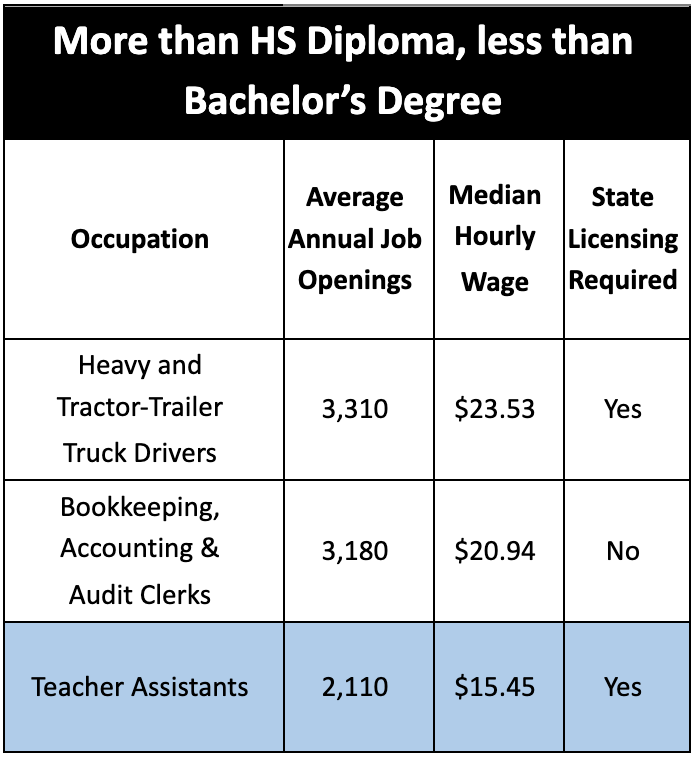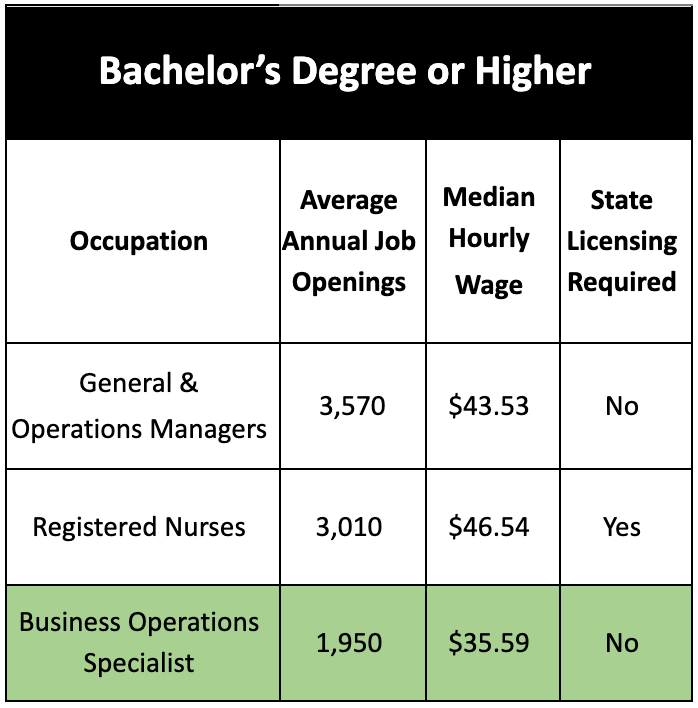Job Shortages
The tables below show the top three occupations that are projected from 2018-2028 of Oregon employers based on the level of education they require. There is a state minimum wage of $12.00 in Oregon. The one highlighted occupation under each of the three education levels has been selected to expand on in terms of potential career advancement.



Potential Career Advancement
1) Retail Salesperson to Supervisor of Retail Sales Workers

Retail Salesperson Job Description:
- Sell merchandise, such as furniture, motor vehicles, appliances, or apparel to consumers
Entry Level Requirements:
- On-the-job training
- English language proficiency
Supervisor of Retail Sales Workers Job Description:
- Supervise and coordinate activities of retail sales workers in a department
Career Advancement Requirements:
- High School diploma or GED typically required
2) Teacher Assistant to Elementary School Teacher

Teacher Assistant Job Description:
- Assist in the teaching of academic and social skills to students at any and all school levels
Entry Level Requirements:
- Associate’s degree OR HS diploma and 2 years of full-time college credit OR pass a state exam
- Obtain current certification in first aid and pediatric CPR within 90 days of employment
Elementary School Teacher Job Description:
- Teach academic and social skills to students at the elementary school level
Career Advancement Requirements:
- Obtain Bachelor’s degree
- Complete state-approved teacher program from an accredited school
- Pass a series of state exams
- Complete background check
3) Business Operations Specialist to General & Operations Manager

Business Operations Specialist Job Description:
- Design and implement solutions to challenges faced in the operations of a business
Entry Level Requirements:
- No licensing requirements, but employer may prefer a bachelor’s degree
- Business degree programs in Oregon are found here
General & Operations Manager Job Description:
- Manages the operations of an organization including the formulation of policies
Career Advancement Requirements:
- No licensing requirements, but typically requires 5 or more years of work experience
- Employers may prefer a graduate degree like an MBA
Immigration in Oregon
The following are facts about the immigrant community in Oregon:
- Immigrants comprise 10% of the state population and 13% of the Oregon labor force
- Top industries of immigrant employment in Oregon:
- Manufacturing, 55,584
- Health Care and Social Assistance, 37,248
- Accommodation and Food Services, 34,383
- Retail Trade, 26,504
- Agriculture, Forestry, Fishing and Hunting, 22,844
- 29,857 immigrant business owners account for 11% of all self-employed Oregon residents
- 45% of immigrants in Oregon are naturalized and another 26% are undocumented
- Top foreign-born countries of origin:
- Mexico, 36%
- Vietnam, 6%
- China, 5%
- India, 5%
- The Philippines, 4%
- 11% of native-born Oregonians are children of an immigrant
- Educational attainment of foreign born adults in Oregon:
- High School diploma or less – 50%
- More than HS diploma, less than Bachelor’s degree – 21%
- Bachelor’s degree or higher – 29%
- Share of Brain Waste* – 21%
* Share of immigrant professionals, who are unemployed, employed at poverty-level wages in High School diploma or less jobs, or significantly underemployed in more than HS diploma, less than Bachelor’s degree jobs
Sources
Jobs
Projections Managing Partnership (PMP), Projections Central – State Occupational Projections, “Long Term Occupational Projection (2018-2028)”; http://www.projectionscentral.com/Projections/LongTerm
Bureau of Labor Statistics, May 2019 State Occupational Employment and Wage Estimates; https://www.bls.gov/oes/current/oessrcst.htm
Bureau of Labor Statistics, Employment Projections, “Education and training assignments by detailed occupation,” 2019; https://www.bls.gov/emp/tables/education-and-training-by-occupation.htm
National Council of State Legislatures, “State Minimum Wages”, December 2020; http://www.ncsl.org/research/labor-and-employment/state-minimum-wage-chart.aspx#Table
Bureau of Labor Statistics, Economic News Release, “Employees on Nonfarm Payrolls by State, Seasonally adjusted”, November 2020; https://www.bls.gov/news.release/laus.t03.htm
Potential Career Advancement
National Conference of State Legislatures, “The National Occupational Licensing Database”, March 2020: https://www.ncsl.org/research/labor-and-employment/occupational-licensing-statute-database.aspx
Immigration
American Immigration Council, State by State Fact Sheet, August 2020; https://www.americanimmigrationcouncil.org/topics/state-by-state





